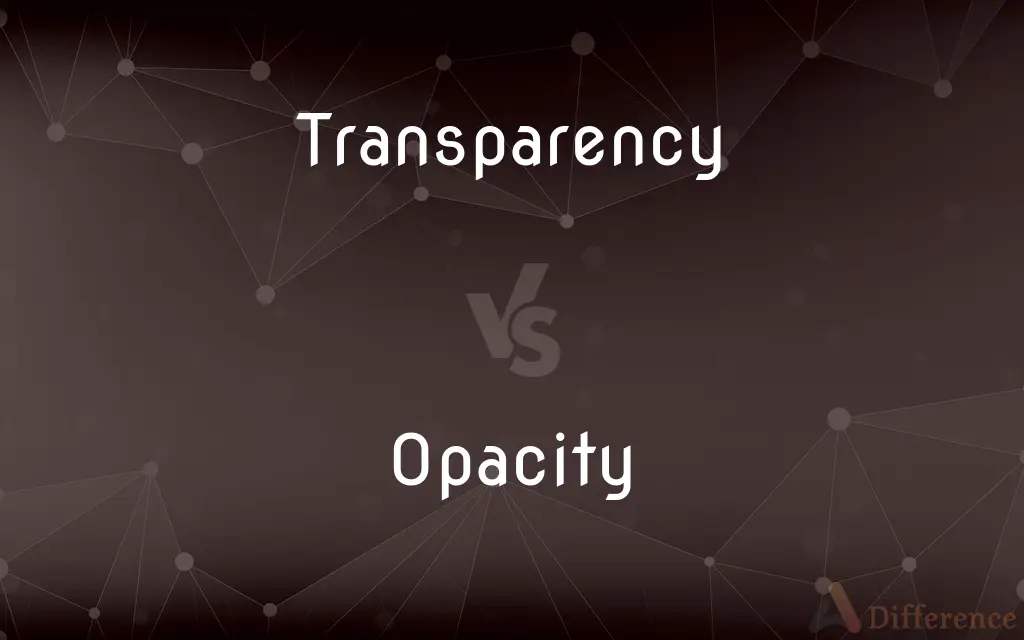Transparency vs. Opacity — What's the Difference?
By Urooj Arif & Fiza Rafique — Updated on March 7, 2024
Transparency refers to the clarity and openness in communication or material's ability to let light pass through, while opacity is the measure of how impenetrable a substance is to light or how concealed information is.

Difference Between Transparency and Opacity
Table of Contents
ADVERTISEMENT
Key Differences
Transparency in a material context describes the property of allowing light to pass through so that objects behind can be distinctly seen. In organizational or informational contexts, it denotes the openness and willingness to share information freely and clearly, fostering trust and understanding. Opacity, conversely, refers to the quality of blocking light, making materials or substances not see-through, or to situations where information is withheld, making processes or decisions difficult to understand.
Transparency is often sought after in governance, business, and personal relationships, as it implies honesty, accountability, and clear communication, enabling stakeholders to make informed decisions. Opacity, while negative in contexts requiring openness, can be desirable in certain materials for privacy or in strategies where confidentiality is essential. It is context-dependent, with its desirability varying based on the need for privacy, security, or aesthetic preference in materials.
Materials that exhibit transparency, such as glass or clear plastics, are utilized for their ability to allow unimpeded vision, used in windows, lenses, and screens. Opacity in materials like wood, metal, or opaque plastics, serves different functions, such as providing coverage, protection, or decoration, where transparency is not beneficial.
The degree of transparency or opacity in organizational practices can significantly impact public perception, trust, and engagement. High transparency is generally associated with ethical practices, encouraging scrutiny and participation, while opacity can lead to suspicion and a lack of trust, although it may be employed to protect sensitive information.
Transparency and opacity serve as contrasting but essential concepts in both physical materials and the flow of information. Their value and application depend heavily on context, with transparency promoting clarity and trust, and opacity offering concealment and protection.
ADVERTISEMENT
Comparison Chart
Definition
Ability to transmit light or openness in communication.
Ability to block light or concealment in communication.
Contexts
Materials science, governance, business.
Materials science, privacy strategies, business.
Desirable Qualities
Clarity, honesty, openness.
Concealment, privacy, protection.
Applications
Windows, lenses, transparent governance.
Walls, doors, confidential strategies.
Implications
Promotes trust and informed decision-making.
Provides privacy, security, or aesthetic preference.
Compare with Definitions
Transparency
The quality of being clear and transparent in materials.
The transparency of the glass allowed sunlight to fill the room.
Opacity
The use of deliberate concealment or complexity in processes.
The strategic opacity of the negotiation tactics kept the competition guessing.
Transparency
The property of a substance that allows light to pass through it.
The transparency of the water revealed the coral beneath.
Opacity
A lack of transparency in communication or information.
The organization's opacity regarding its internal operations caused public distrust.
Transparency
A situation where information is readily available and understandable.
The transparency of the research process enhanced its credibility.
Opacity
The property of a material that prevents the passage of light.
The paint's opacity was perfect for covering the old markings.
Transparency
Openness and honesty in communication or processes.
The company's transparency about its financial status built investor confidence.
Opacity
The degree to which something is difficult to understand or interpret.
The contract's language had a level of opacity that required legal advice.
Transparency
The characteristic of a government or organization to be open about its activities.
Voter trust increased due to the government's transparency.
Opacity
The condition of being opaque and not allowing light to pass through.
The opacity of the curtains blocked out the morning light.
Transparency
The condition of being transparent
The transparency of ice
Opacity
The quality or state of being opaque.
Transparency
A positive transparent photograph printed on transparent plastic or glass, able to be viewed using a slide projector
Colour transparencies of the Grand Canyon
Opacity
Something opaque.
Transparency
Also trans·par·ence (-pârəns, -păr-) The quality or state of being transparent.
Opacity
Obscurity; impenetrability.
Transparency
A transparent object, especially a photographic slide that is viewed by light shining through it from behind or by projection.
Opacity
Dullness of mind.
Transparency
(uncountable) The quality of being transparent; transparence.
Opacity
(uncountable) The state or quality of being opaque, not allowing light to pass through
We could not see the sandbar due to the opacity of the muddy water.
Transparency
(uncountable) Openness; accessibility to scrutiny.
Opacity
(uncountable) The state or quality of being inaccessible to understanding.
The opacity of these decisions is troubling.
Transparency
A transparent artwork, viewable by shining light through it.
Opacity
A measure of relative impenetrability to electromagnetic radiation such as light.
The opacity of a clean glass window is near zero.
Transparency
A translucent film-like material with an image imprinted on it, viewable by shining light through it.
Opacity
The state of being opaque; the quality of a body which renders it impervious to the rays of light; want of transparency; opaqueness.
Transparency
(countable) A transparent object.
Opacity
Obscurity; want of clearness.
Transparency
(signal processing) Sufficient accuracy to make the compressed result perceptually indistinguishable from the uncompressed input.
Opacity
The phenomenon of not permitting the passage of electromagnetic radiation
Transparency
The quality or condition of being transparent; transparence.
Opacity
Incomprehensibility resulting from obscurity of meaning
Transparency
That which is transparent; especially, a picture painted on thin cloth or glass, or impressed on porcelain, or the like, to be viewed by natural or artificial light, which shines through it.
Opacity
The quality of being opaque to a degree; the degree to which something reduces the passage of light
Transparency
Permitting the free passage of electromagnetic radiation
Transparency
The quality of being clear and transparent
Transparency
Picture consisting of a positive photograph or drawing on a transparent base; viewed with a projector
Common Curiosities
Why is opacity sometimes preferred in materials?
Opacity is preferred when privacy, protection from light, or specific aesthetic qualities are desired, as it prevents visibility through the material.
What is transparency in governance?
Transparency in governance refers to the openness and accessibility of government actions, policies, and data to the public, promoting accountability and trust.
Can an organization be both transparent and opaque?
Yes, an organization can be transparent in certain areas, such as financial disclosures, while maintaining opacity in others, like strategic decisions, to protect competitiveness.
How does transparency affect trust?
Transparency often increases trust among stakeholders by providing clear and accessible information, allowing for informed decision-making and demonstrating accountability.
What role does transparency play in environmental sustainability?
Transparency is crucial in environmental sustainability, as it allows stakeholders to assess the environmental impact of practices and supports informed consumer choices and policy-making.
Can technological advancements impact transparency and opacity?
Yes, technology can enhance transparency by making information more accessible and improve methods of ensuring privacy and security, affecting opacity.
What are the challenges of implementing transparency?
Challenges include balancing openness with privacy and security, managing the volume of information, and ensuring the accuracy and clarity of disclosed data.
What is the significance of opacity in art?
In art, opacity can manipulate visibility, create texture, and add depth or mystery to a piece, enhancing its emotional or visual impact.
Is opacity always negative in business contexts?
Not always. Opacity in certain business practices, such as protecting intellectual property or sensitive negotiations, is necessary for competitive advantage and security.
How does opacity affect consumer perception?
Opacity can lead to consumer suspicion and mistrust if it is perceived that information is being deliberately hidden or is difficult to access.
How can transparency be measured?
Transparency can be measured by the availability, accessibility, and comprehensibility of information provided by an entity to its stakeholders.
What are the legal implications of opacity?
Legal implications may include potential scrutiny or sanctions if opacity violates regulations regarding transparency, especially in financial disclosures or governance.
What is the role of opacity in personal privacy?
Opacity is crucial for personal privacy, as it allows individuals to control the visibility of their personal information and protect themselves from undue scrutiny or exploitation.
How is opacity used in digital security?
Opacity, through encryption and privacy settings, is used in digital security to protect information from unauthorized access and ensure user privacy.
How do transparency and opacity influence market dynamics?
They influence market dynamics by affecting investor confidence, consumer trust, and competitive strategies, with transparency generally seen as stabilizing and opacity as potentially destabilizing.
Share Your Discovery

Previous Comparison
Bronchospasm vs. Bronchoconstriction
Next Comparison
Coffee vs. CocoaAuthor Spotlight
Written by
Urooj ArifUrooj is a skilled content writer at Ask Difference, known for her exceptional ability to simplify complex topics into engaging and informative content. With a passion for research and a flair for clear, concise writing, she consistently delivers articles that resonate with our diverse audience.
Co-written by
Fiza RafiqueFiza Rafique is a skilled content writer at AskDifference.com, where she meticulously refines and enhances written pieces. Drawing from her vast editorial expertise, Fiza ensures clarity, accuracy, and precision in every article. Passionate about language, she continually seeks to elevate the quality of content for readers worldwide.















































